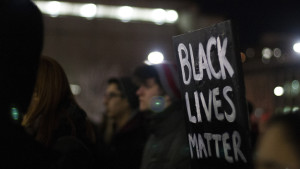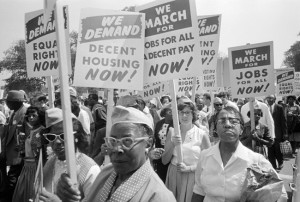Last week, a Washington Post op-ed written by Civil Rights Movement veteran Barbara Reynolds sparked the ire of activists involved in the current Black Lives Matter campaign. The piece expressed support for some of the goals of the movement, but expressed skepticism about the tactics and optics of BLM. Her work, and the subsequent backlash, point to the search for a usable past from African American activists—not just now, but throughout African American history. No movement can succeed unless it draws some lessons from previous struggles. BLM seems to be aware of this, but draws different lessons from some of the participants in the Civil Rights Movement.
Reynolds argued in her piece, “BLM seems intent on rejecting our proven methods. This movement is ignoring what our history has taught.”[1] She mentioned that today’s tactics are divisive, and in comparison with those used in the 1960s by civil rights protestors they seem to be far too aggressive. Such an argument forgets how often the protest tactics used in Birmingham, Albany, Selma, and elsewhere were seen as too aggressive. Sit-in tactics were criticized by other civil rights activists as soon as they were utilized in 1960. And, of course, the epithet of “outside agitator” was constantly thrown at activists during the 1950s and 1960s.
However, I think it would also be a mistake to completely reject Reynolds’ analysis of the current moment. She does, after all, acknowledge how BLM has embraced LGTBQ and Trans* people of color, along with the fact that the movement is one led largely by women. Reynolds’ exhortation to BLM members to consider talking about the problems of police violence affecting other minority groups, and even white Americans, is definitely  worth considering. Her critique contains some other areas of concern—comparing the responses to the tragedy in Charleston to the police-community clashes in Baltimore and Ferguson, as though they are the exact same type of issue, for one—but it does come from a place of concern. Further, it must be recognized that the fight for Black equality has always included debate about the best tactics to use at any given time.
worth considering. Her critique contains some other areas of concern—comparing the responses to the tragedy in Charleston to the police-community clashes in Baltimore and Ferguson, as though they are the exact same type of issue, for one—but it does come from a place of concern. Further, it must be recognized that the fight for Black equality has always included debate about the best tactics to use at any given time.
In short, BLM is not following the traditional Civil Rights Movement script. In doing so, historians must make it clear that such a script—namely, adhering to civil disobedience and nonviolent activism—was but a tool created for a specific time period in American history. Agitation and activism can take many forms. Today’s activists, it can be argued, respect and cherish the accomplishments of their forerunners fifty years ago. But they also believe that today’s problems of police violence cannot be solved through so-called “respectability politics.”
Clarence Lang has argued, in his book Black America in the Shadow of the Sixties, that African American memory of the Civil Rights Movement is contingent on what generation you belong to. For African American men and women who were born or grew up in the 1980s, for example, the lessons of the 1960s may seem different than for those who were alive during the Civil Rights Movement. Plus, depending on the past as a crutch  for understanding modern social movements, without a nuanced understanding of that past, risks making null and void the lessons that can be applied to the present. Wrote Lang: “An overreliance on the Sixties threatens to suffocate our contemporary political imagination, prevent us from more concretely locating our own selves in the conditions and demands of the present.”[2] In other words, activists involved in BLM—or for that matter, any other social movement—would do well to look beyond the 1960s. If this means pulling from the anti-lynching crusade, the New Negro movement, the anti-Apartheid campaign of the 1970s and 1980s, and beyond, then so be it.
for understanding modern social movements, without a nuanced understanding of that past, risks making null and void the lessons that can be applied to the present. Wrote Lang: “An overreliance on the Sixties threatens to suffocate our contemporary political imagination, prevent us from more concretely locating our own selves in the conditions and demands of the present.”[2] In other words, activists involved in BLM—or for that matter, any other social movement—would do well to look beyond the 1960s. If this means pulling from the anti-lynching crusade, the New Negro movement, the anti-Apartheid campaign of the 1970s and 1980s, and beyond, then so be it.
It is not surprising that so many lessons are being drawn from the 1960s right now. We are in the midst of an anniversary-mania, commemorating the fiftieth anniversary of many events. As I’ve written before, however, we seem to have done far less to remember the 150th anniversary of the end of the Civil War, or the start of the Reconstruction period. As 2016 approaches, it will be interesting to see who commemorates the “start” of the Black Power movement. I would be the last person to tell BLM what lessons they should draw–or, for that matter, what advice older activists should offer them. As a historian, all I can say is this: we should worry about a usable past. We should, however, worry even more about how that past is used.
[1] Barbara Reynolds, “I Was a Civil Rights Activist in the 1960s. But it’s hard for me to get behind Black Lives Matter,” washingtonpost.com, accessed August 29, 2015.
[2] Clarence Lang, Black America in the Shadow of the Sixties: Notes on the Civil Rights Movement, Neoliberalism, and Politics. (Ann Arbor: University of Michigan Press, 2015), p. 3.

2 Thoughts on this Post
S-USIH Comment Policy
We ask that those who participate in the discussions generated in the Comments section do so with the same decorum as they would in any other academic setting or context. Since the USIH bloggers write under our real names, we would prefer that our commenters also identify themselves by their real name. As our primary goal is to stimulate and engage in fruitful and productive discussion, ad hominem attacks (personal or professional), unnecessary insults, and/or mean-spiritedness have no place in the USIH Blog’s Comments section. Therefore, we reserve the right to remove any comments that contain any of the above and/or are not intended to further the discussion of the topic of the post. We welcome suggestions for corrections to any of our posts. As the official blog of the Society of US Intellectual History, we hope to foster a diverse community of scholars and readers who engage with one another in discussions of US intellectual history, broadly understood.
This tension is particularly interesting in light of David Krugler’s new book on the 1919 violence and Black organizing then that laid the foundation for the CRM: CRM looks more like a transitional period, maybe?
http://historynewsnetwork.org/article/160430
I think you make some good points there. It will be interesting to see how the CRM is contextualized the further we get away from it. I sometimes think our present moment has more to do with the 1890s–a sluggish economy, a political upheaval with no clear answer–but there isn’t a perfect historical analogue for our age. It’s like an amalgamation of problems from other parts of America’s history.